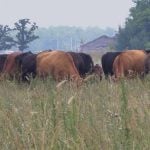Organic farmers should consider controlling weeds by clipping them above the canopy of short crops such as lentils and flax.
Preliminary results of a three-year project indicate that weed clipping has potential as an integrated weed management practice for organic producers.
“Managing weeds is a challenge for organic growers,” said Eric Johnson, a soils and crops agrologist at Agriculture Canada’ s Scott Research Farm.
“Herbicides are not allowed, so organic producers must rely on crop rotation, cultural practices and mechanical weed control.”
The project was organized by organic farmers and led by Gordon Hultgreen, soils and crops manager at the Prairie Agricultural Machinery Institute in Humboldt, Sask.
Read Also

Alberta eases water access for riparian restoration
Alberta government removes requirement for temporary diversion licence to water plants up to 100 cubic metres per day for smaller riparian restoration projects
Researchers looked at developing or modifying equipment for weed clipping, and evaluated whether the practice improved crop yield and reduced weed seedling emergence the following growing season.
They modified the cutting component of a self-propelled swather and carried out field trials on four sites with check strips and cut strips of flax and lentils.
“The results of these trials were dramatic on some sites, especially those where weed infestation was particularly bad,” Hultgreen said.
“In one, for example, the weed count following the first year of clipping showed 37 wild oats per sq. metre on the check strip and eight wild oats on the clipped strip. On a cleaner site, the check site had three wild oats and the clipped site had one.”
He said the key is to cut before seeds are advanced enough to be viable.
“These results are very encouraging. In fact, one organic producer is already adapting machinery for this use. Next spring’ s count will be most telling, as we will see whether the clipping has a sustained effect.”
Johnson evaluated weed clipping in lentils. He conducted two controlled experiments in two years.
Various stages of weed clipping were evaluated, and one of the experiments was expanded to determine whether clippings should be removed from the field to prevent weed seeds from returning to the soil.
“Preliminary results show that weed clipping did not improve the yield of lentil in either experiment,” Johnson said.
“But this is not a surprise, because the clipping must be postponed until the weeds begin to elongate above the crop canopy, and most of the yield loss associated with weed competition occurs in the early stages of crop development.”
But he said weed clipping may reduce weed problems the following year.
In both experiments, wild oat emergence was reduced by more than 50 percent the year after clipping. Wild mustard emergence was significantly reduced in one of the two experiments, with 91 plants per sq. m in the check plot and eight plants per sq. m in the clipped plot.
“Lambsquarters was present in only one experiment, and its density was reduced from 36 plants per sq. m in the untreated check to six plants per sq. m in the clipped treatments. Preliminary analysis suggests that removal of the clippings from the field was not necessary to reduce wild mustard or lambsquarters seed return, but there may be a benefit with wild oat.”
A final report on the project will be available in early 2002.
















